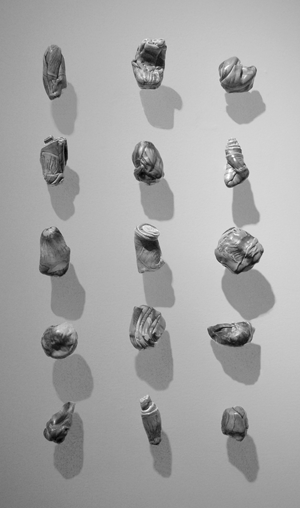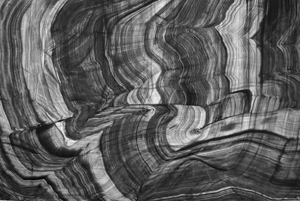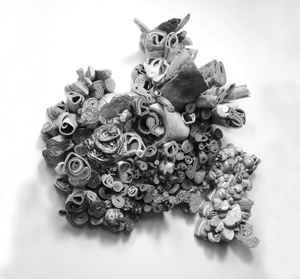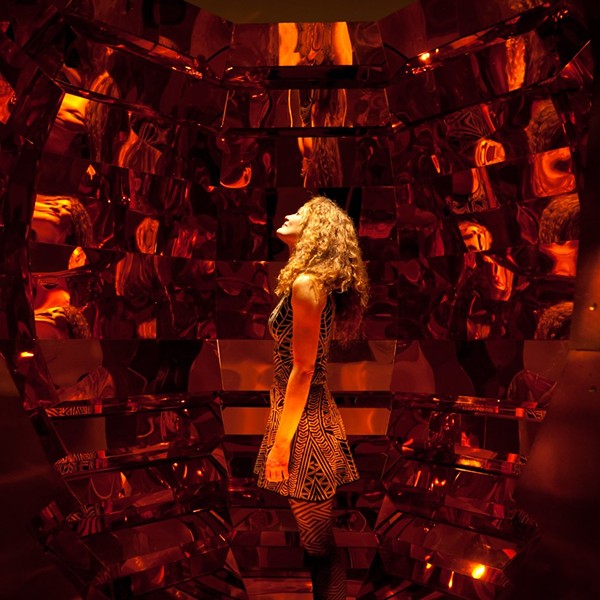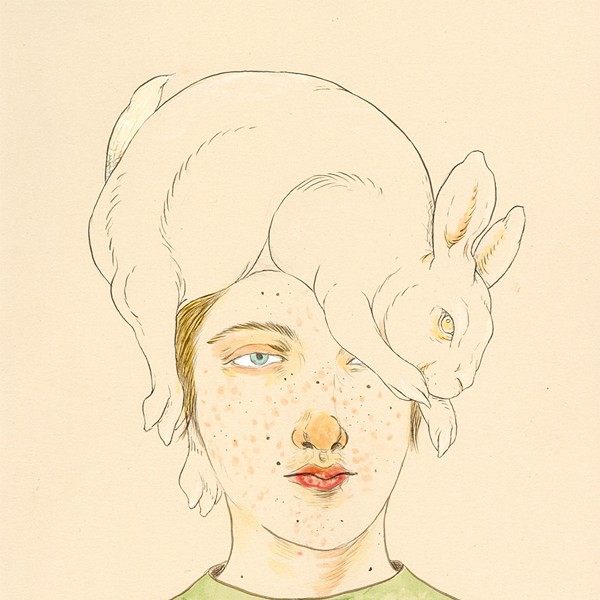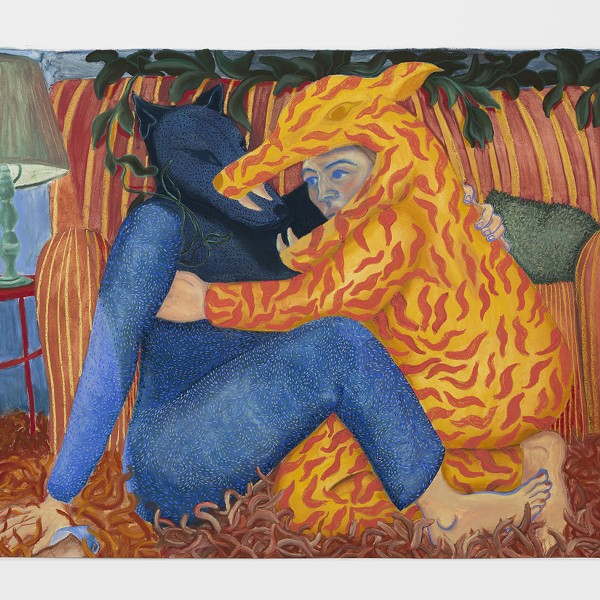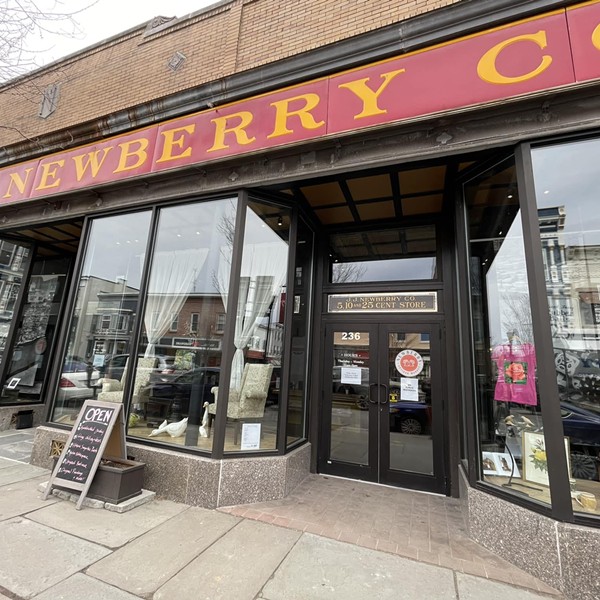Born and raised in Beacon, Laura Moriarty’s art has developed through her own, unique process as well. Not one to follow a well-worn path, early on she sensed that academic training would not accommodate her needs. She became an artist through an internship at Women’s Studio Workshop and tremendous dedication to her work. Starting as a paper- and printmaker, she moved into using encaustic (wax-based paint), developing most recently a unique body of work that builds up strange, colorfully striated forms that strain the boundaries between painting and sculpture. Thinking through categories provided by natural science—plate tectonics, geological processes, even the systematic mapping of archeological sites—Moriarty’s latest installations sprawl into enormous accretions of encaustic, reminiscent of fairy grottos or perhaps magical coral reefs.
Moriarty is busy these days, exhibiting in this month’s SiteLines art fair invitational exhibition, participating in a show at the Oberpfalzer Kunstlerhaus in Schwandorf, Germany, and building a new studio, funded through a prestigious Pollock-Krasner Grant that she received last year. In addition to all that, she’s the Gallery Director for R&F Handmade Paints, organizing one of the more innovative exhibition programs in the area.
On not going to art school
I wanted to go [to art school] at first, but I didn’t have much money, so I went to community college, and I was very turned off right away. Even at that level, it’s for people who have been groomed, to a certain degree. Everybody else is weeded out, and not encouraged. The head of the department told me that I should be a lawyer. There really wasn’t much more you could say to offend me. Can I have my money back, please?
I decided the best way to learn is to get out there and do it. So I sought out artists, rather than schools. I didn’t think I would learn in school. Almost all my artist friends have MFAs—I don’t think less of them because of that, but I have to say there’s a certain thing there that I just would never accept [for myself]. I’m very idealistic about that.
So I went to WSW and asked how I could get involved. I trained as an apprentice papermaker for four years under Tatana Kellner, and that is where I learned. They really just let you grow. There was no meddling, no head games. They really just let me go and didn’t judge me—there was a long time that I made not good work—and at a certain point, while I was making prints there, Ann [Kalmbach] just walked into the studio and said, “It’s time for you to have a show.” And that was it. I was just allowed to let the work come into its own. No one was telling me how to package it until there was something to package. It was a very unusual process. I am so grateful for it.
Invented worlds
I began thinking a few years ago about creating a piece that could be site-specific, that could travel around to different places, and be experienced almost the way you would experience a dollhouse, or a botanical garden, or some other kind of created environment. It’s not a natural environment, but it’s a very curious environment for people. And one which plays with human scale so that you get into it, move through it with your eyes, with your vision and your imagination, rather than your body. I made a pedestal that just sat on the floor, with a big cluster [of paint] sitting on it. It had pathways in it, and overhangs. It was very geologic, very much inspired by plate tectonics and all these things I’ve been thinking about in my work for a long time. The playfulness of the interaction with the people really got me excited.
We tend to compartmentalize nature, but I see it as just this big mess. Everything’s all put together. The way that it all breaks down is gorgeous, that’s where the beauty is. If I can help people contemplate that, that’s really intriguing.
A moving target
It’s always moving with me. I always think “This is it” when I catch on to something that I really like and enjoy about the work. I always think “I’m just going to do this for the rest of my life.” That will last a year or so, and then some sort of mutation slips in, to the point where I see the relationships, the mental leaps very clearly and logically, but other people are asking, “Where’s this coming from?”
I almost think of myself as a trickster-scientist. Or a fictionalized scientist that’s working behind the scenes, and the pieces are just the evidence of my study. Like I’m proving my answers somehow. Even if it isn’t an answer. They’re open.
Letting go
You don’t want your work to fall apart. You want it to stay together, and be presentable, and all this stuff that means you’re a good, responsible businessperson. But I think that very recently I let go of that, and realized that it’s the fragility itself that I’m interested in. I want these things to look like they’re on the brink of collapse, and in order to look that way,
they pretty much have to be ready to collapse. It seems like when I was putting them on the wall, I was imposing too much of that kind of business sense to the work, and with these, I think that may be the relationship to outsider art. I’ve said no—they’re fragile, that’s what they are. The folds and faults, that becomes the record, and the record is what it is. I fully expect that these will change. They will erode, and they do for me.
All those pretty things
I think I’m becoming more interested in being able to articulate this work from an ecological perspective. It keeps me engaged in the work, to think who am I as a person, and how am I expressing those concerns in the thing that I’m most passionate about. For me, making pretty things has never been enough. I think the world is full of pretty things. And even things, period. Part of this whole letting them break is being less attached to the thing, the precious object, and letting the parts be more important, the detritus. It’s about regeneration. It’s a different way to stay intellectually engaged with the work, for myself—I’m not trying to preach that to other people, though. You know, [in an elevated voice], “My work speaks to the…” [laughter]. No, I definitely don’t see myself above it, I’m part of it. I’m as flawed as it is.
The day job
I never said, “I’m going to be a gallery director when I grow up.” They pretty much had to drag me, kicking and screaming, into it. I always want to do “day job” as little as possible. That’s the goal. I want day jobs where I don’t have to hate what I’m doing, or call in sick, lie to people. R&F is so pro-artist, this is really a dream job for me. It’s an all-artist staff, so that’s fun. The company has a really nice gallery now, which is like a gift to the artists who show there. So that feels great. I can call people up and ask, “Would you like to show at R&F?” and there’s no hesitation, they just say “Yes!” I love having the opportunity to be kind to artists in a way that the system doesn’t necessarily allow. It’s great to feel that at least we can do this one little thing right.







